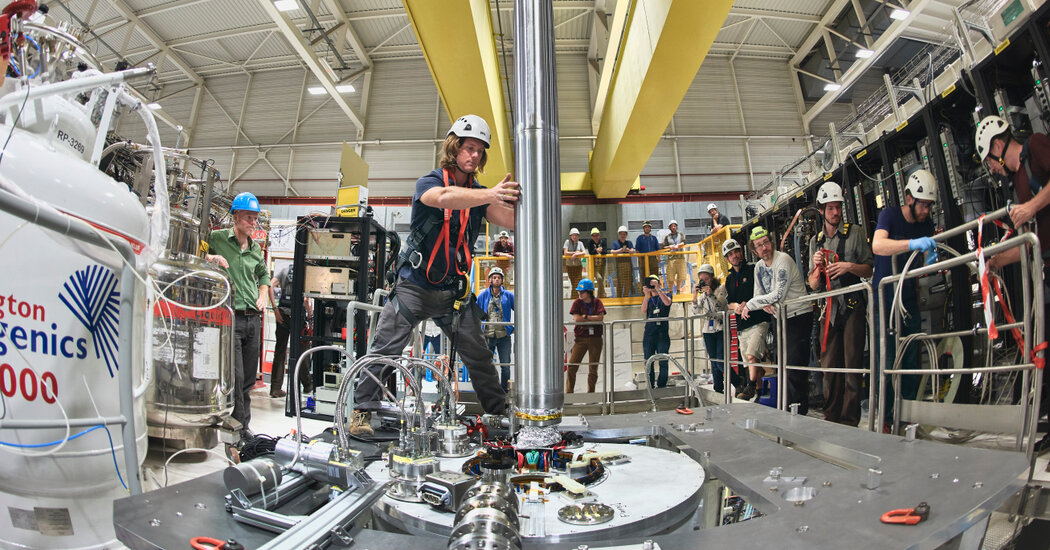Antimatter just lost a little more pizazz.
Physicists know that for every fundamental particle in nature there is an antiparticle — an evil twin of identical mass but endowed with equal and opposite characteristics like charge and spin. When these twins meet, they obliterate each other, releasing a flash of energy on contact.
In science fiction, antiparticles provide the power for warp drives. Some physicists have speculated that antiparticles are being repelled by gravity or even traveling backward in time.
A new experiment at CERN, the European Center for Nuclear Research, brings some of that speculation back down to Earth. In a gravitational field, it turns out, antiparticles fall just like the rest of us. “The bottom line is that there’s no free lunch, and we’re not going to be able to levitate using antimatter,” said Joel Fajans of the University of California, Berkeley.
Dr. Fajans was part of an international team known as ALPHA, the Antihydrogen Laser Physics Apparatus collaboration, which is based at CERN and led by Jeffrey Hangst, a particle physicist at Aarhus University in Denmark. Dr. Fajans and his colleagues assembled about 100 hundred anti-atoms of hydrogen and suspended them in a magnetic field. When the field was slowly ramped down, the anti-hydrogen atoms drifted down like maple leaves in October and at the same rate of downward acceleration, or g force, as regular atoms: about 32 feet per second per second. They published their result on Wednesday in the journal Nature.
Few physicists were surprised by the result. According to Einstein’s theory of general relativity, all forms of matter and energy respond equally to gravity.
“If you walk down the halls of this department and ask the physicists, they would all say that this result is not the least bit surprising,” Jonathan Wurtele, a physicist at the University of California, Berkeley, said in an announcement issued by the university. It was he who first suggested the experiment to Dr. Fajans a decade ago. “That’s the reality,” Dr. Wurtele said.
“But most of them will also say that the experiment had to be done because you never can be sure,” he added. “The opposite result would have had big implications.”
The Looking-Glass World
In 1928, in one of the most astonishing examples of nature following math, the physicist Paul Dirac found that a quantum mechanical equation describing the electron had two solutions. In one, the electron was negatively charged; this particle is the workhorse of chemistry and electricity. In the other solution, the particle was positively charged.
What was that particle? Dirac thought it was the proton, but J. Robert Oppenheimer, later famous for the atomic bomb, suggested it was a brand-new particle: a positron, identical to an electron but with a positive charge and spin. Two years later Carl Anderson, of the California Institute of Technology, detected positrons in cosmic ray showers, a discovery that earned him a Nobel Prize in Physics.
And so the lure of antimatter was born. Positively charged protons, which dominate atomic nuclei, are matched by negatively charged antiprotons. Anti-electrons are called positrons. Neutrons, which also reside in atomic nuclei, have anti-neutrons. The quarks that make up protons have anti-quarks, and so on.
In principle, there could be entire antiworlds inhabited by antibeings. The joke goes that if you met your antiself, that person would stick out a left hand to shake, but you had better not take it or you would both blow up.
For scientists, the thrill of antimatter is not simply in adding to a list of weirdly named particles. To them, studying anti-hydrogen atoms is the first step toward testing some of the deepest hypotheses about nature, which hold that antimatter should look and behave identically to ordinary matter.
For the last 20 years, scientists from the ALPHA group have been collecting antimatter at CERN, siphoning high-energy antiprotons from collisions in the Large Hadron Collider and slowing them from the speed of light to speeds of a few hundred feet per second and a temperature of about 15 degrees above absolute zero. The antiprotons are then mixed with a cloud of anti-electrons, or positrons, produced by the decay of radioactive sodium, in a so-called mixing trap controlled by electrical fields.
Normal hydrogen, the simplest and most abundant element in the universe, consists of a positively charged proton attended by a negatively charged electron. The ALPHA experiment results in a few atoms of anti-hydrogen: The nucleus is an antiproton, and a positron circles it.
In 2002 Dr. Hangst reported that these anti-hydrogen atoms emitted and absorbed light at the same frequencies and wavelengths as regular hydrogen, just as Einstein would have predicted. Since then, many experiments, all indirect, have strongly suggested that antimatter also gravitates normally, Dr. Fajans said. But those experiments have not been conclusive, because gravity is less than one-trillionth as strong as the electromagnetic fields used to manipulate the anti-atoms.
Anti-Messages in a Bottle
In the latest experiment, the anti-hydrogen atoms were confined by a magnetic field inside a 10-inch-long metal container. Since, like hydrogen, anti-hydrogen atoms carry a slight magnetic field of their own, they bounce off the walls of this bottle.
The magnetic fields can also be tuned to counter gravity and suspend the anti-hydrogen atoms in the bottle. In the experiment, when the fields were slowly ramped down, the atoms eventually escaped the field and annihilated themselves in a flash on the walls of the chamber. About 80 percent of these flashes occurred below the chamber, according to statistical analyses. This suggests that gravity typically acts to pull anti-atoms downward, just as it would with normal matter.
Any violation of the expected symmetry between hydrogen and anti-hydrogen would have rocked physics to its core.
That did not happen, Dr. Wurtele said. “This experiment is the first time that a direct measurement of the force of gravity on neutral antimatter has been made,” he said. “It’s another step in developing the field of neutral antimatter science.”
But the result leaves hanging another puzzle. According to relativity and to quantum mechanics — the two quarreling theories that rule the universe — the Big Bang should have created equal amounts of matter and antimatter, which should have annihilated each other long ago.
Yet our universe is all matter, with nary a speck of antimatter to be found outside of cosmic ray showers and particle-collider collisions. So what happened? Why does the cosmos contain something rather than nothing? The question has burned for almost a century already.
Three years ago an experiment in Japan involving the strange particles known as neutrinos reported what might be a clue to the cosmic imbalance. At the Large Hadron Collider, an entire instrument, called LHCb, is devoted to searching for any differences between matter and antimatter that could have tipped the cosmic balance.
Asked whether the results from the ALPHA experiment offered any insights for the LHCb team, Dr. Wurtele said, “Since our answer is consistent with normal gravity, I don’t think it gives any hints, unfortunately.” Which is another way of saying we still don’t know why we’re here.











